Peach
The peach (Prunus persica) is a deciduous tree native to the region of Northwest China between the Tarim Basin and the north slopes of the Kunlun Mountains, where it was first domesticated and cultivated.[3] It bears edible juicy fruits with various characteristics, most called peaches and others (the glossy-skinned varieties), nectarines.
| Peach | |
|---|---|
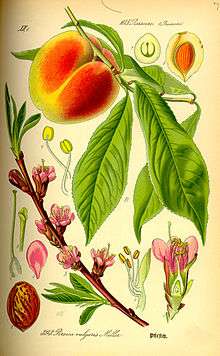 | |
| Peach flower, fruit, seed and leaves as illustrated by Otto Wilhelm Thomé (1885). | |
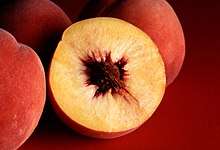 | |
| Autumn Red peaches, cross section showing freestone variety | |
| Scientific classification | |
| Kingdom: | Plantae |
| Clade: | Tracheophytes |
| Clade: | Angiosperms |
| Clade: | Eudicots |
| Clade: | Rosids |
| Order: | Rosales |
| Family: | Rosaceae |
| Genus: | Prunus |
| Subgenus: | Prunus subg. Amygdalus |
| Species: | P. persica |
| Binomial name | |
| Prunus persica | |
| Synonyms[2] | |
|
Synonymy
| |
The specific name persica refers to its widespread cultivation in Persia (modern-day Iran), from where it was transplanted to Europe. It belongs to the genus Prunus, which includes the cherry, apricot, almond and plum, in the rose family. The peach is classified with the almond in the subgenus Amygdalus, distinguished from the other subgenera by the corrugated seed shell. Due to their close relatedness, the inside of a peach stone tastes remarkably similar to almond, and peach stones are often used to make a cheap version of marzipan, known as persipan.[4]
Peaches and nectarines are the same species, even though they are regarded commercially as different fruits. The skin of nectarines lacks the fuzz (fruit-skin trichomes) that peach-skin has; it is thought that a mutation in a single gene (MYB25) is responsible for the hair or no-hair difference between the two.[5][6]
In 2018, China produced 62% of the world total of peaches and nectarines.[7]
Description
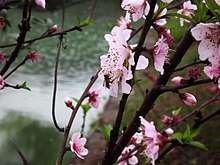
Prunus persica grows up to 7 m (23 ft) tall and wide. However, when pruned properly, trees are usually 3–4 m (10–13 ft) tall and wide.[8] The leaves are lanceolate, 7–16 cm (3–6 1⁄2 in) long, 2–3 cm (3⁄4–1 1⁄4 in) broad, pinnately veined. The flowers are produced in early spring before the leaves; they are solitary or paired, 2.5–3 cm diameter, pink, with five petals. The fruit has yellow or whitish flesh, a delicate aroma, and a skin that is either velvety (peaches) or smooth (nectarines) in different cultivars. The flesh is very delicate and easily bruised in some cultivars, but is fairly firm in some commercial varieties, especially when green. The single, large seed is red-brown, oval shaped, approximately 1.3–2 cm long, and is surrounded by a wood-like husk. Peaches, along with cherries, plums and apricots, are stone fruits (drupes). There are various heirloom varieties, including the Indian Peach, or Indian Blood Peach, which arrives in the latter part of the summer, and can have color ranging from red and white, to purple.[9]
Cultivated peaches are divided into clingstones and freestones, depending on whether the flesh sticks to the stone or not; both can have either white or yellow flesh. Peaches with white flesh typically are very sweet with little acidity, while yellow-fleshed peaches typically have an acidic tang coupled with sweetness, though this also varies greatly. Both colors often have some red on their skin. Low-acid white-fleshed peaches are the most popular kinds in China, Japan, and neighbouring Asian countries, while Europeans and North Americans have historically favoured the acidic, yellow-fleshed cultivars.
Etymology
The scientific name persica, along with the word "peach" itself and its cognates in many European languages, derives from an early European belief that peaches were native to Persia (modern-day Iran). The Ancient Romans referred to the peach as malum persicum "Persian apple", later becoming French pêche, whence the English peach.[10] The scientific name, Prunus persica, literally means "Persian plum", as it is closely related to the plum.
Fossil record
Fossil endocarps with characteristics indistinguishable from those of modern peaches have been recovered from late Pliocene deposits in Kunming, dating to 2.6 million years ago. In the absence of evidence that the plants were in other ways identical to the modern peach, the name Prunus kunmingensis has been assigned to these fossils.[11]
History
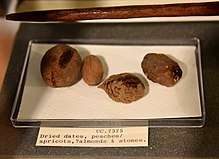
Although its botanical name Prunus persica refers to Persia (present Iran) from where it came to Europe, genetic studies suggest peaches originated in China,[12] where they have been cultivated since the neolithic period. Until recently, it was believed that the cultivation started c. 2000 BC.[13][14] More recent evidence indicates that domestication occurred as early as 6000 BC in Zhejiang Province of China. The oldest archaeological peach stones are from the Kuahuqiao site. Archaeologists point to the Yangtze River Valley as the place where the early selection for favorable peach varieties probably took place.[15] Peaches were mentioned in Chinese writings and literature beginning from the early 1st millennium BC.[16]
A domesticated peach appeared very early in Japan, in 4700–4400 BC, during the Jōmon period. It was already similar to modern cultivated forms, where the peach stones are significantly larger and more compressed than earlier stones. This domesticated type of peach was brought into Japan from China. Nevertheless, in China itself, this variety is currently attested only at a later date of c. 3300 to 2300 BC.[15]
In India, the peach first appeared by c. 1700 BC, during the Harappan period.[17]
It is also found elsewhere in Western Asia in ancient times.[18] Peach cultivation reached Greece by 300 BC.[14] It is often claimed that Alexander the Great introduced the fruit into Europe after he conquered the Persians,[18] although there is no historical evidence for this belief.[19] Peaches were, however, well known to the Romans in the 1st century AD;[14] the oldest known artistic representations of the fruit are in two fragments of wall paintings, dated to the 1st century AD, in Herculaneum, preserved due to the Vesuvius eruption of 79 AD and now held in the National Archaeological Museum in Naples.[20] Archaeological finds show that peaches were cultivated widely in Roman north-western Continental Europe, but production collapsed around the sixth century; some revival of production followed with the Carolingian Renaissance of the ninth century.[21]
The peach was brought to the Americas by Spanish explorers in the 16th century, and eventually made it to England and France in the 17th century, where it was a prized and expensive treat. The horticulturist George Minifie supposedly brought the first peaches from England to its North American colonies in the early 17th century, planting them at his Estate of Buckland in Virginia.[22] Although Thomas Jefferson had peach trees at Monticello, American farmers did not begin commercial production until the 19th century in Maryland, Delaware, Georgia, South Carolina, and finally in Virginia.
In April 2010, an international consortium, the International Peach Genome Initiative (IPGI), that include researchers from the United States, Italy, Chile, Spain, and France announced they had sequenced the peach tree genome (doubled haploid Lovell). Recently, IPGI published the peach genome sequence and related analyses. The peach genome sequence is composed of 227 million nucleotides arranged in eight pseudomolecules representing the eight peach chromosomes (2n = 16). In addition, a total of 27,852 protein-coding genes and 28,689 protein-coding transcripts were predicted.
Particular emphasis in this study is reserved for the analysis of the genetic diversity in peach germplasm and how it was shaped by human activities such as domestication and breeding. Major historical bottlenecks were individuated, one related to the putative original domestication that is supposed to have taken place in China about 4,000–5,000 years ago, the second is related to the western germplasm and is due to the early dissemination of the peach in Europe from China and the more recent breeding activities in the United States and Europe. These bottlenecks highlighted the substantial reduction of genetic diversity associated with domestication and breeding activities.[23]
Cultivation
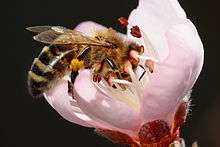
Peaches grow in a fairly limited range in dry, continental or temperate climates, since the trees have a chilling requirement that tropical or subtropical areas generally do not satisfy except at high altitudes (for example in certain areas of Ecuador, Colombia, Ethiopia, India, and Nepal). Most cultivars require 500 hours of chilling around 0 to 10 °C (32 to 50 °F). During the chilling period, key chemical reactions occur, but the plant appears dormant. Once the chilling period is fulfilled, the plant enters a second type of dormancy, the quiescence period. During quiescence, buds break and grow when sufficient warm weather favorable to growth is accumulated.[24]
The trees themselves can usually tolerate temperatures to around −26 to −30 °C (−15 to −22 °F), although the following season's flower buds are usually killed at these temperatures, preventing a crop that summer. Flower bud death begins to occur between −15 and −25 °C (5 and −13 °F), depending on the cultivar and on the timing of the cold, with the buds becoming less cold tolerant in late winter.[25]
Another climate constraint is spring frost. The trees flower fairly early (in March in western Europe) and the blossom is damaged or killed if temperatures drop below about −4 °C (25 °F). However, if the flowers are not fully open, they can tolerate a few degrees colder.
Climates with significant winter rainfall at temperatures below 16 °C (61 °F) are also unsuitable for peach cultivation as the rain promotes peach leaf curl, which is the most serious fungal disease for peaches. In practice, fungicides are extensively used for peach cultivation in such climates, with >1% of European peaches exceeding legal pesticide limits in 2013.[26]
Finally, summer heat is required to mature the crop, with mean temperatures of the hottest month between 20 and 30 °C (68 and 86 °F).
Typical peach cultivars begin bearing fruit in their third year. Their lifespan in the U.S. varies by region; the University of California at Davis gives a lifespan of about 15 years[27] while the University of Maine gives a lifespan of 7 years there.[28]
Cultivars
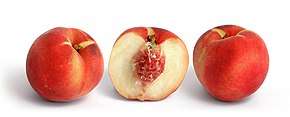
Hundreds of peach and nectarine cultivars are known. These are classified into two categories—freestones and clingstones. Freestones are those whose flesh separates readily from the pit. Clingstones are those whose flesh clings tightly to the pit. Some cultivars are partially freestone and clingstone, so are called semifree. Freestone types are preferred for eating fresh, while clingstone types are for canning. The fruit flesh may be creamy white to deep yellow, to dark red; the hue and shade of the color depend on the cultivar.[29]
Peach breeding has favored cultivars with more firmness, more red color, and shorter fuzz on the fruit surface. These characteristics ease shipping and supermarket sales by improving eye appeal. However, this selection process has not necessarily led to increased flavor. Peaches have a short shelf life, so commercial growers typically plant a mix of different cultivars to have fruit to ship all season long.[30]
Different countries have different cultivars. In the United Kingdom, for example, these cultivars have gained the Royal Horticultural Society's Award of Garden Merit:
Nectarines
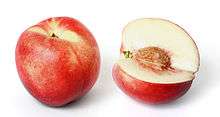
The variety P. persica var. nucipersica (or var. nectarina), commonly called nectarine, has a smooth skin. It is on occasion referred to as a "shaved peach" or "fuzzless peach", due to its lack of fuzz or short hairs.
Peacherines
Peacherines are claimed to be a cross between a peach and a nectarine, and are marketed in Australia and New Zealand. The fruit is intermediate in appearance between a peach and a nectarine, large and brightly colored like a red peach. The flesh of the fruit is usually yellow, but white varieties also exist. The Koanga Institute lists varieties that ripen in the Southern Hemisphere in February and March.[35][36]
Flat peaches
Flat peaches or pan-tao have a flattened shape in contrast to ordinary rounded peaches.[37]
Planting
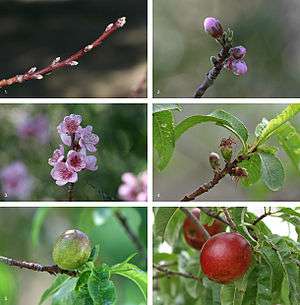
Most peach trees sold by nurseries are cultivars budded or grafted onto a suitable rootstock. Common rootstocks are 'Lovell Peach', 'Nemaguard Peach', Prunus besseyi, and 'Citation'.[38] This is done to improve predictability of the fruit quality.
Peach trees need full sun, and a layout that allows good natural air flow to assist the thermal environment for the tree. Peaches are planted in early winter. During the growth season, peach trees need a regular and reliable supply of water, with higher amounts just before harvest.[39]
Peaches need nitrogen-rich fertilizers more than other fruit trees. Without regular fertilizer supply, peach tree leaves start turning yellow or exhibit stunted growth. Blood meal, bone meal, and calcium ammonium nitrate are suitable fertilizers.
The number of flowers on a peach tree is typically thinned out because if the full amount of peaches mature on a branch, they are undersized and lacking in flavor. Fruits are thinned midway in the season by commercial growers. Fresh peaches are easily bruised and do not store well. They are most flavorful when they ripen on the tree and are eaten the day of harvest.[39]
The peach tree can be grown in an espalier shape. The Baldassari palmette is a palmette design created around 1950 used primarily for training peaches. In walled gardens constructed from stone or brick, which absorb and retain solar heat and then slowly release it, raising the temperature against the wall, peaches can be grown as espaliers against south-facing walls as far north as southeast Great Britain and southern Ireland.
Insects
The first pest to attack the tree early in the year when other food is scarce is the earwig (Forficula auricularia) which feeds on blossoms and young leaves at night, preventing fruiting and weakening newly planted trees. The pattern of damage is distinct from that of caterpillars later in the year, as earwigs characteristically remove semicircles of petal and leaf tissue from the tips, rather than internally. Greasebands applied just before blossom are effective.[40]
The larvae of such moth species as the peachtree borer (Synanthedon exitiosa), the yellow peach moth (Conogethes punctiferalis), the well-marked cutworm (Abagrotis orbis), Lyonetia prunifoliella, Phyllonorycter hostis, the fruit tree borer (Maroga melanostigma), Parornix anguliferella, Parornix finitimella, Caloptilia zachrysa, Phyllonorycter crataegella, Trifurcula sinica, Suzuki's promolactis moth (Promalactis suzukiella), the white-spotted tussock moth (Orgyia thyellina), the apple leafroller (Archips termias), the catapult moth (Serrodes partita), the wood groundling (Parachronistis albiceps) or the omnivorous leafroller (Platynota stultana) are reported to feed on P. persica. The flatid planthopper (Metcalfa pruinosa) causes damage to fruit trees.
The tree is also a host plant for such species as the Japanese beetle (Popillia japonica), the unmonsuzume (Callambulyx tatarinovii), the promethea silkmoth (Callosamia promethea), the orange oakleaf (Kallima inachus), Langia zenzeroides, the speckled emperor (Gynanisa maja) or the brown playboy (Deudorix antalus). The European red mite (Panonychus ulmi) or the yellow mite (Lorryia formosa) are also found on the peach tree.
It is a good pollen source for honey bees and a honeydew source for aphids.
Diseases
Peach trees are prone to a disease called leaf curl, which usually does not directly affect the fruit, but does reduce the crop yield by partially defoliating the tree. Several fungicides can be used to combat the disease, including Bordeaux mixture and other copper-based products (the University of California considers these organic treatments), ziram, chlorothalonil, and dodine.[41] The fruit is susceptible to brown rot or a dark reddish spot.
Production
| Peach (and nectarine) production, 2018 | ||
|---|---|---|
(millions of tonnes) | ||
In 2018, world production of peaches (combined with nectarines for reporting) was 24.5 million tonnes, led by China with 62% of the world total (table).
The U.S. state of Georgia is known as the "Peach State" due to its significant production of peaches as early as 1571,[46] with exports to other states occurring around 1858.[47] In 2014, Georgia was third in US peach production behind California and South Carolina.[46]
Cultural significance
Peaches are not only a popular fruit, but are symbolic in many cultural traditions, such as in art, paintings and folk tales such as Peaches of Immortality.
China
Peach blossoms are highly prized in Chinese culture. The ancient Chinese believed the peach to possess more vitality than any other tree because their blossoms appear before leaves sprout. When early rulers of China visited their territories, they were preceded by sorcerers armed with peach rods to protect them from spectral evils. On New Year's Eve, local magistrates would cut peach wood branches and place them over their doors to protect against evil influences.[48] Peachwood was also used for the earliest known door gods during the Han. Another author writes:
The Chinese also considered peach wood (t'ao-fu) protective against evil spirits, who held the peach in awe. In ancient China, peach-wood bows were used to shoot arrows in every direction in an effort to dispel evil. Peach-wood slips or carved pits served as amulets to protect a person's life, safety, and health.[49]
Peach-wood seals or figurines guarded gates and doors, and, as one Han account recites, "the buildings in the capital are made tranquil and pure; everywhere a good state of affairs prevails".[49] Writes the author, further:
Another aid in fighting evil spirits were peach-wood wands. The Li-chi (Han period) reported that the emperor went to the funeral of a minister escorted by a sorcerer carrying a peach-wood wand to keep bad influences away. Since that time, peach-wood wands have remained an important means of exorcism in China.[49]
Peach kernels (桃仁 táo rén) are a common ingredient used in traditional Chinese medicine to dispel blood stasis, counter inflammation and reduce allergies.[50]
It was in an orchard of flowering peach trees that Liu Bei, Guan Yu, and Zhang Fei took an oath of brotherhood in the opening chapter of the classic Chinese novel Romance of the Three Kingdoms. Another peach forest, “The Peach Blossom Spring” by poet Tao Yuanming is the setting of the favourite Chinese fable and a metaphor of utopias. A peach tree growing on a precipice was where the Taoist master Zhang Daoling tested his disciples.[51]
The Old Man of the South Pole one of the deities of the Chinese folk religion fulu shou is sometimes seen holding a large peach, representing long life and health.
The term "bitten peach", first used by Legalist philosopher Han Fei in his work Han Feizi, became a byword for homosexuality. The book records the incident when courtier Mizi Xia bit into an especially delicious peach and gave the remainder to his lover, Duke Ling of Wei, as a gift so that he could taste it as well.
Korea
In Korea, peaches have been cultivated from ancient times. According to Samguk Sagi, peach trees were planted during the Three Kingdoms of Korea period, and Sallim gyeongje also mentions cultivation skills of peach trees. The peach is seen as the fruit of happiness, riches, honours and longevity. The rare peach with double seeds is seen as a favorable omen of a mild winter. It is one of the ten immortal plants and animals, so peaches appear in many minhwa (folk paintings). Peaches and peach trees are believed to chase away spirits, so peaches are not placed on tables for jesa (ancestor veneration), unlike other fruits.[52][53]
Japan
The world’s sweetest peach happens to grow in Fukushima, Japan. The Guinness World Records for the world’s sweetest peach is currently held by a peach grown in Kanechika, Japan, with a sugar content of 22.2. However, a fruit farm in rural Fukushima, Koji grew a much sweeter peach, with a Brix score of 32 Degrees. Degrees Brix measures the sugar content of the fruit and it is usually between 11 and 15 for typical peach from a supermarket.[54]
Vietnam
A Vietnamese mythic history states that, in the spring of 1789, after marching to Ngọc Hồi and then winning a great victory against invaders from the Qing dynasty of China, the Emperor Quang Trung ordered a messenger to gallop to Phú Xuân citadel (now Huế) and deliver a flowering peach branch to the Princess Ngọc Hân. This took place on the fifth day of the first lunar month, two days before the predicted end of the battle. The branch of peach flowers that was sent from the north to the centre of Vietnam was not only a message of victory from the King to his wife, but also the start of a new spring of peace and happiness for all the Vietnamese people. In addition, since the land of Nhật Tân had freely given that very branch of peach flowers to the King, it became the loyal garden of his dynasty.
It was by a peach tree that the protagonists of the Tale of Kieu fell in love. And in Vietnam, the blossoming peach flower is the signal of spring. Finally, peach bonsai trees are used as decoration during Vietnamese New Year (Tết) in northern Vietnam.
Europe
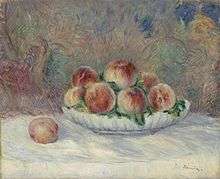
Many famous artists have painted still life with peach fruits placed in prominence. Caravaggio, Vicenzo Campi, Pierre-Auguste Renoir, Claude Monet, Édouard Manet, Henri Fantin-Latour, Severin Roesen, Peter Paul Rubens, Van Gogh are among the many influential artists who painted peaches and peach trees in various settings.[55][56] Scholars suggest that many compositions are symbolic, some an effort to introduce realism.[57] For example, Tresidder claims[58] the artists of Renaissance symbolically used peach to represent heart, and a leaf attached to the fruit as the symbol for tongue, thereby implying speaking truth from one's heart; a ripe peach was also a symbol to imply a ripe state of good health. Caravaggio paintings introduce realism by painting peach leaves that are molted, discolored or in some cases have wormholes – conditions common in modern peach cultivation.[56]
United States
South Carolina named the peach its official fruit in 1984.[59] The peach became the state fruit of Georgia, nicknamed the "Peach State", in 1995.[60] The peach went from feral trees utilized opportunistically to a tended commercial crop in the Southern United States in the 1850s, as the boll weevil attacked regional cotton crops. When Georgia reached peak production in the 1920s, elaborate festivals celebrated the fruit. By 2017, Georgia's production was 3–5% of the U. S. total.[61][62] Alabama named it the "state tree fruit" in 2006.[63] Delaware's state flower has been the peach blossom since 1995,[64] and peach pie became its official dessert in 2009.[65]
Nutrition and research
Gallery
- A peach tree in blossom
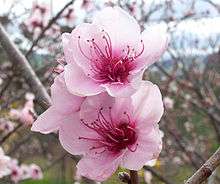 Peach blossoms
Peach blossoms Incipient fruit development
Incipient fruit development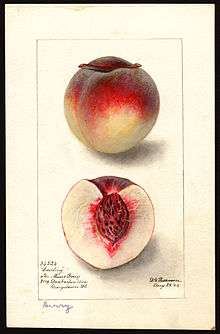 Peach (cultivar 'Berry') – watercolour 1895
Peach (cultivar 'Berry') – watercolour 1895 Claude Monet, A Jar of Peaches, c. 1866
Claude Monet, A Jar of Peaches, c. 1866
References
- "IPNI Plant Name Query Results". ipni.org. Archived from the original on 25 September 2015.
- The Plant List, Prunus persica (L.) Batsch
- Faust, M.; Timon, B. L. (2010). "Origin and Dissemination of Peach". Horticultural Reviews. p. 331. doi:10.1002/9780470650585.ch10. ISBN 978-0-470-65058-5.
- Haase, Ilka; Brüning, Philipp; Matissek, Reinhard; Fischer, Markus (10 April 2013). "Real-time PCR assays for the quantitation of rDNA from apricot and other plant species in marzipan". Journal of Agricultural and Food Chemistry. 61 (14): 3414–3418. doi:10.1021/jf3052175. ISSN 1520-5118. PMID 23495652.
- "Frequently Asked Questions". Oregon State University. Archived from the original on 14 July 2008.
- Vendramin, Elisa; Pea, Giorgio; Dondini, Luca; Pacheco, Igor; Dettori, Maria Teresa; Gazza, Laura; Scalabrin, Simone; Strozzi, Francesco; Tartarini, Stefano (3 March 2014). "A Unique Mutation in a MYB Gene Cosegregates with the Nectarine Phenotype in Peach". PLOS ONE. 9 (3): e90574. doi:10.1371/journal.pone.0090574. ISSN 1932-6203. PMC 3940905. PMID 24595269.
- "Production of peaches and nectarines in 2018; Crops/Regions/World/Production Quantity (from pick lists)". United Nations, Food and Agricultural Organization, Statistics Division (FAOSTAT). 2019. Retrieved 11 April 2020.
- "The Average Width of a Peach Tree". SFGate. Hearst Communications Inc. Retrieved 23 October 2018.
- "Indian Peaches Information, Recipes and Facts". Specialtyproduce.com. Archived from the original on 20 September 2012. Retrieved 24 September 2012.
- Campbell, Lyle (2004) Historical Linguistics: An Introduction, 2nd ed., Cambridge, Massachusetts: MIT Press, p. 274. ISBN 0-262-53267-0.
- Su, T.; et al. (2016). "Peaches Preceded Humans: Fossil Evidence from SW China". Scientific Reports. Nature Publishing Group. 5: 16794. Bibcode:2015NatSR...516794S. doi:10.1038/srep16794. PMC 4660870. PMID 26610240.
- Thacker, Christopher (1985). The history of gardens. Berkeley: University of California Press. p. 57. ISBN 978-0-520-05629-9.
- Singh, Akath; Patel, R.K.; Babu, K.D.; De, L.C. (2007). "Low chiling peaches". Underutilized and underexploited horticultural crops. New Delhi: New India Publishing. p. 90. ISBN 978-81-89422-69-1.
- Geissler, Catherine (2009). The New Oxford Book of Food Plants. Oxford: Oxford University Press. p. 82. ISBN 978-0-19-160949-7.
- Yang, Xiaoyan; Zheng, Yunfei; Crawford, Gary W.; Chen, Xugao (2014). "Archaeological Evidence for Peach (Prunus persica) Cultivation and Domestication in China". PLOS ONE. 9 (9): e106595. Bibcode:2014PLoSO...9j6595Z. doi:10.1371/journal.pone.0106595. ISSN 1932-6203. PMC 4156326. PMID 25192436.
- Layne, Desmond R.; Bassi, Daniele (2008). The Peach: Botany, Production and Uses. CAB International. ISBN 978-1-84593-386-9.
- Fuller, D; Madella, M (2001). "Issues in Harappan Archaeobotany: Retrospect and Prospect". In Settar, S; Korisettar, R (eds.). Indian Archaeology in Retrospect. Volume II. Protohistory. New Delhi: Manohar. pp. 317–390.
- Ensminger, Audrey H. (1994). Foods & nutrition encyclopedia. CRC Press. ISBN 0-8493-8980-1.
- Davidson, Alan (1999). The Oxford Companion to Food (1 ed.). Oxford: Oxford University Press. p. 588. ISBN 0-19-211579-0.
- Sadori, Laura; et al. (2009). "The introduction and diffusion of peach in ancient Italy" (PDF). Edipuglia. Archived (PDF) from the original on 14 January 2013. Cite journal requires
|journal=(help) - Noah Blan, 'Charlemagne’s Peaches: A Case of Early Medieval European Ecological Adaptation', Early Medieval Europe, 27.4 (2019), 521–45.
- "George Minifie". Genforum.genealogy.com. 21 March 1999. Archived from the original on 14 January 2013. Retrieved 24 September 2012.
- Verde, I.; Abbott, A.G.; Scalabrin, S.; Jung, S.; et al. (2013). "The high-quality draft genome of peach (Prunus persica) identifies unique patterns of genetic diversity, domestication and genome evolution". Nature Genetics. 45 (5): 487–494. doi:10.1038/ng.2586. hdl:2434/218547. PMID 23525075.
- "Peach tree physiology" (PDF). University of Georgia. 2007. Archived from the original (PDF) on 10 June 2010.
- Szalay, L.; Papp, J.; Szaóbo, Z. (2000). "Evaluation of frost tolerance of peach varieties in artificial freezing tests". Acta Horticulturae. 538 (538): 407–410. doi:10.17660/ActaHortic.2000.538.71.
- European Food Safety Authority (2015). "The 2013 European Union report on pesticide residues in food". EFSA Journal. 13 (3): 4038. doi:10.2903/j.efsa.2015.4038. Archived from the original on 15 March 2015.
The highest maximum residue level (MRL) exceedance rate was found for strawberries (2.5% of the samples), followed by lettuce (2.3%), oats (1.3%), peaches (1.1%), and apples (1.0%).
- "Fruit and Nut Varieties for Low-Elevation Sierra Foothills" (PDF). University of California at Davis. November 2009. Archived (PDF) from the original on 12 June 2010. Retrieved 25 August 2015.
- "Growing Peaches in Maine". Archived from the original on 26 August 2015. Retrieved 25 August 2015.
- "Peach and Nectarine Culture". University of Rhode Island. 2000. Archived from the original on 14 January 2013.
- Okie, W.R. (2005). "Varieties – Peaches" (PDF). United States Department of Agriculture. Archived from the original (PDF) on 14 January 2013.
- "RHS Plant Selector Prunus persica 'Duke of York' (F) AGM / RHS Gardening". Apps.rhs.org.uk. Archived from the original on 14 January 2013. Retrieved 24 September 2012.
- "RHS Plant Selector Prunus persica 'Peregrine' (F) AGM / RHS Gardening". Apps.rhs.org.uk. Archived from the original on 14 January 2013. Retrieved 24 September 2012.
- "RHS Plant Selector Prunus persica 'Rochester' (F) AGM / RHS Gardening". Apps.rhs.org.uk. Archived from the original on 14 January 2013. Retrieved 24 September 2012.
- "RHS Plant Selector Prunus persica var. nectarina 'Lord Napier' (F) AGM / RHS Gardening". Apps.rhs.org.uk. Archived from the original on 14 January 2013. Retrieved 24 September 2012.
- "Almonds, Nectarines, Peacherines and Apricots". Koanga Institute. Archived from the original on 15 February 2014. Retrieved 8 January 2014.
- Shimabukuro, Betty (7 July 2004). "Mixed marriages: Cross-pollination produces fruit "children" that aren't quite the same as mom and dad". Honolulu Star-Bulletin. Archived from the original on 2 March 2012. Retrieved 8 January 2014.
- Layne, Desmond (2008). The Peach: Botany, Production and uses. CABI. p. 16. ISBN 978-1-84593-386-9. Retrieved 3 August 2015.
- Ingels, Chuck; et al. (2007). The Home Orchard: Growing Your Own Deciduous Fruit and Nut Trees. University of California Agriculture and Natural Resources. pp. 29–30.
- McCraw, Dean. "Planting and Early Care of the Peach Orchard". Oklahoma Cooperative Extension Service. Archived (PDF) from the original on 16 September 2012.
- "Wer frisst Pfirsich-Blütenknopsen?" [Who eats peach blossom buds?]. Garten-pur.de (in German). 9 April 2010. Archived from the original on 2 January 2014. Retrieved 1 January 2014.
- "UC Pest Management Guidelines". UC Davis. 10 September 2015. Archived from the original on 19 January 2016. Retrieved 3 November 2015.
- Trainotti, L.; Tadiello, A.; Casadoro, G. (2007). "The involvement of auxin in the ripening of climacteric fruits comes of age: The hormone plays a role of its own and has an intense interplay with ethylene in ripening peaches". Journal of Experimental Botany. 58 (12): 3299–3308. doi:10.1093/jxb/erm178. PMID 17925301.
- Ziosi, V.; Bregoli, A. M.; Fiori, G.; Noferini, M.; Costa, G. (2007). "1-MCP effects on ethylene emission and fruit quality traits of peaches and nectarines". Advances in Plant Ethylene Research. p. 167. doi:10.1007/978-1-4020-6014-4_38. ISBN 978-1-4020-6013-7.
- "Prunus persica, peach, nectarine". GeoChemBio.com. Archived from the original on 25 July 2012. Retrieved 24 September 2012.
- "Healthy and Sustainable Food". The Center for Health and the Global Environment. Harvard Medical School. 16 November 2011. Archived from the original on 11 February 2012. Retrieved 24 September 2012.
- Kathryn C. Taylor (15 August 2003). "Peaches". New Georgia Encyclopedia. Georgia Humanities Council and the University of Georgia Press. Archived from the original on 5 July 2015. Retrieved 3 August 2015.
- Fair, John D. (2002). "The Georgia Peach and the Southern Quest for Commercial Equity and Independence, 1843-1861". Georgia Historical Quarterly. 86 (3): 372. Retrieved 19 February 2018.
- Doré S.J., Henry; Kennelly, S. J. (translator), M. (1914). Researches into Chinese Superstitions. V. Tusewei Press, Shanghai. p. 505.
- Simoons, Frederick J. (1991) Food in China: A Cultural and Historical Inquiry, p. 218, ISBN 0-8493-8804-X.
- "TCM: Peach kernels" (in Chinese). Archived from the original on 16 July 2011. Retrieved 1 November 2010.
- Eskildsen, Stephen (1998). Asceticism in early taoist religion. SUNY Press. p. 26. ISBN 978-0-7914-3955-5. Archived from the original on 16 May 2016.
- 한국에서의 복숭아 재배 [Peach cultivation in Korea] (in Korean). Nate / Britannica. Archived from the original on 24 May 2012. Retrieved 12 January 2010.
- 복숭아 [Peach] (in Korean). Nate / Encyclopedia of Korean Culture. Archived from the original on 24 May 2012. Retrieved 12 January 2010.
- "The world's sweetest peach costs $7,000. So is it worth the price tag?". www.abc.net.au. 17 July 2020. Retrieved 18 July 2020.
- Torpy, Janet M. (2010). "Still Life With Peaches". JAMA. 303 (3): 203. doi:10.1001/jama.2009.1853. PMID 20085943.
- Jules Janick. "Caravaggio's Fruit: A Mirror on Baroque Horticulture" (PDF). Archived from the original (PDF) on 14 January 2013. Retrieved 24 September 2012.
- de Groft; Aaron H. (2006). "Caravaggio – Still Life with Fruit on a Stone Ledge" (PDF). Papers of the Muscarelle Museum of Art, Volume 1. Archived from the original (PDF) on 14 January 2013.
- Tresidder, Jack (2004). 1,001 Symbols: An Illustrated Guide to Imagery and Its Meaning. ISBN 978-0-8118-4282-2.
- Plants & Edibles, South Carolina Legislature Online, retrieved 29 May 2019
- "State Fruit". Georgia State Symbols. Georgia Secretary of State. Retrieved 29 May 2019.
- Okie, William Thomas (14 August 2017), "The Fuzzy History of the Georgia Peach", Smithsonian.com, retrieved 29 May 2019
- Mackie, Matt (1 November 2018), "Is Georgia really the Peach State?", wxga.com, retrieved 29 May 2019
- "State Tree Fruit of Alabama". Alabama Emblems, Symbols and Honors. Alabama Department of Archives and History. 20 April 2006. Retrieved 29 May 2019.
- "Delaware State Plants". Delaware.gov. Retrieved 30 May 2019.
- "Delaware Miscellaneous Symbols". Delaware.gov. Retrieved 29 May 2019.
Further reading
- Okie, William Thomas. The Georgia Peach: Culture, Agriculture, and Environment in the American South (Cambridge Studies on the American South, 2016).
External links
| Wikimedia Commons has media related to |
| Wikispecies has information related to Prunus persica |